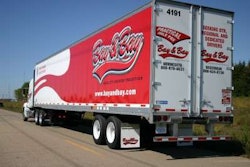USA Truck today, Jan. 29, announced base revenue of $92.9 million for the three months ended Dec. 31, a decrease of 2.9 percent from $95.7 million for the same quarter of 2007. Net income increased to $0.6 million from a net loss of $1.6 million.
Base revenue increased 1.6 percent to $397.6 million for the 12 months ended Dec. 31 from $391.2 million for the same period of 2007. Net income increased to $3.1 million from $0.1 million.
“While we are not satisfied with our results, we are proud of our year-over-year improvements in the face of unprecedented economic conditions,” said Clifton R. Beckham, president and chief executive officer of the Van Buren, Ark.-based company. “We believe that these results reflect tangible progress as we continue to implement our long-term strategic plan. Freight conditions during the fourth quarter were quite possibly the most challenging that we have ever experienced, and that opinion is supported by several truckload industry indices and an avalanche of macroeconomic indicators.”
Beckham said the deterioration in the freight environment took its toll on the company’s fourth-quarter performance. “The most significant impact of the deterioration was a reduction in trucking base revenue, which resulted in a 3.4 percent decline in our tractor utilization,” he said. “We made progress on the various initiatives we have under way to help us achieve our strategic goals of better return on capital and more consistent earnings.”
Beckham said some of that progress came in the form of tactical countermeasures to help offset the current economic challenges, while others remain long-term focused:
Beckham said he believes USA Truck is poised to weather the uncertainty of the next few quarters. “Our balance sheet leverage, less cash, represents just 39.3 percent of our total capitalization, and we have no material off-balance sheet debt,” he said. “Despite a heavy tractor trading program, we produced $39.5 million in free cash flow (cash flow from operations less net capital expenditures) during 2008, which was only $2.7 million less than that of 2007 when we purchased a relatively small number of tractors. We expect our 2009 capital expenditures to more resemble 2007 levels than those of 2008. In summary, we are comfortable with our current liquidity situation.”
Beckham said these past few months have been quite fluid and that predicting the near-term future is difficult at best. “We are watching the macroeconomic situation closely, including industry capacity,” he said. “We believe freight demand is likely to remain depressed over the next few quarters. We believe that weak demand, annual tractor registration and insurance renewal payments and continued tight credit during the first few months of 2009 will combine to drive excess capacity from the market. Falling fuel prices were the only material factor we believe aided industrywide capacity retention, and we do not expect that to be sufficient to outweigh the negative factors for underperforming and undercapitalized competitors going into 2009.
“In the meantime, we will continue the implementation of our long-term strategic plan, and we will manage our capital and our business operations conservatively in the uncertain near-term,” Beckham said. “We believe that our long-term strategic plan positions our business well for performance in difficult times, but it will require intensity and execution on the part of our team. That will be our focus as 2009 unfolds.”









